#frank L. koralewsky
Photo
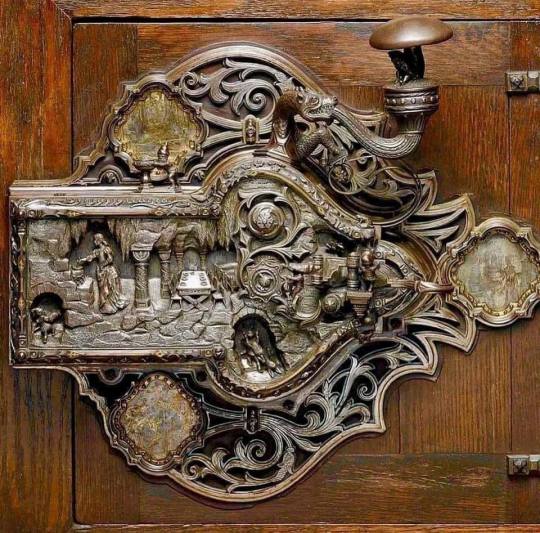
Iron lock (1911) with inlays of gold, silver, bronze, and copper on wood base,
By Frank L. Koralewsky (1872-1941)
© Art Institute of Chicago
#art#design#sculpture#iron#lock#door lock#gold#silver#bronze#coper#frank L. koralewsky#1900s#figure#hand crafted#hand made#collectors
3K notes
·
View notes
Text

From Messynessy.com Frank L. Koralewsky lock Exhibited at the 1915 Panama-Pacific International Exposition, where it won a gold medal, the lock illustrates Jacob and Wilhelm Grimm’s fairy tale “Snow White and the Seven Dwarfs.”
35 notes
·
View notes
Text
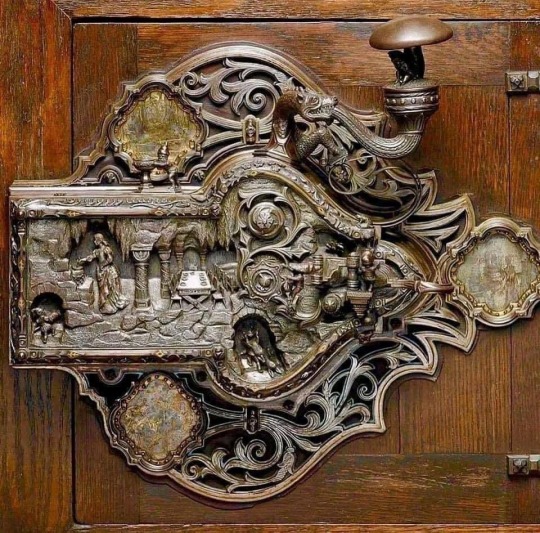
Iron lock (1911) with inlays of gold, silver, bronze, and copper on wood base,
By Frank L. Koralewsky (1872-1941)
5 notes
·
View notes
Text

Arte de leyenda.
Esta es probablemente una de las cerraduras de puerta más hermosas de la historia.
Frank L. Koralewsky (1872-1941) fue un maestro del arte del metal y un actor central en el movimiento Arts and Crafts, un movimiento artesanal que alcanzó su apogeo a finales del siglo XIX y principios del XX.
Este movimiento fue una respuesta a la creciente industrialización y enfatizó la importancia de la artesanía y la expresión artística individual.
Durante esta era de renacimiento artesanal, Koralewsky trabajó en estrecha colaboración con arquitectos notables como Ralph Adams Cram y Guy Lowell.
Estos arquitectos eran conocidos por sus magníficas iglesias y edificios, para los cuales seleccionaron sólo los mejores materiales y artesanos. Koralewsky fue uno de estos artistas seleccionados.
Su especialidad, la herrería decorativa, daba un toque especial a las construcciones.
El arte de Koralewsky fue evidente en muchos aspectos del diseño arquitectónico de la época, desde lunetas hasta manijas de puertas, chimeneas elaboradas, barandillas de escaleras o, como se ve en estas fotografías, cerraduras de puertas.
La habilidad y creatividad de Kissers se expresaron en el diseño de adornos que eran a la vez estéticamente agradables y funcionales.
Frank Koralewsky no sólo fue un artesano, sino también un artista que tenía la habilidad de trabajar el hierro como si fuera mantequilla.
Esta descripción, que le atribuye Otis Skinner, ilustra su extraordinaria capacidad para transformar el metal en formas complejas y delicadas.
Koralewsky dirigía la herrería F. Krasser & Co., donde empleaba aproximadamente a 30 herreros que producían herrajes exquisitos según sus estándares precisos y exigentes.
Trabajando con hierro candente, herramientas pesadas y fuego, estos artesanos crearon delicadas y delicadas obras de arte en metal que no solo eran hermosas sino también resistentes.
0 notes
Photo
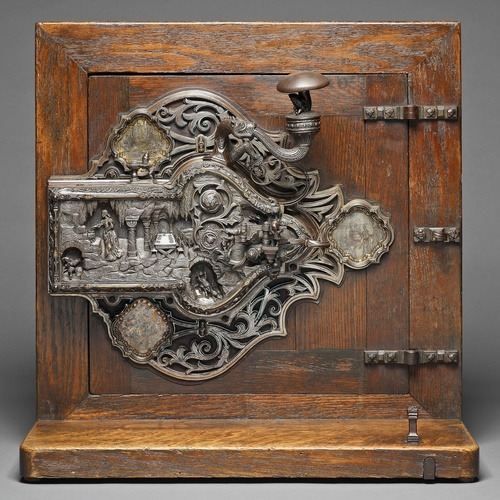
Lock, Frank L. Koralewsky, 1911, Art Institute of Chicago: American Art
Frank L. Koralewsky served as a traditional ironworker’s apprentice in his native north-German town of Stralsund. After obtaining journeyman status, he worked in various German shops before immigrating to Boston in the mid- 1890s. By 1906 he was a member of the Boston Society of Arts and Crafts, specializing in locksmithing and hardware. This extremely intricate lock, which took seven years to complete, exemplifies the early-20th-century taste for sentimental medievalism and represents the pinnacle of the metalworking tradition at the turn of the 20th century. Exhibited at the 1915 Panama-Pacific International Exposition, where it won a gold medal, the lock illustrates Jacob and Wilhelm Grimm’s fairy tale “Snow White and the Seven Dwarfs.” Gift of Mr. Richard T. Crane
Size: 50.8 × 50.8 × 20.3 cm (20 × 20 × 8 in.)
Medium: Iron with inlays of gold, silver, bronze, and copper on wood base
https://www.artic.edu/artworks/28869/
18 notes
·
View notes
Photo

Snow White and the Seven Dwarfs, 1904-1911 Door iron lock with inlays of gold, silver, bronze and copper. At the Panama-Pacific International Exhibition of 1915, He won the gold medal of © Frank L. Koralevsky (Frank L. Koralewsky), Stresund/Boston (1872-1941). @mihmat53
26 notes
·
View notes
Text
http://chert-poberi.ru/wp-content/uploads/proga2018/images4/c0wEYCXv3ZjNNF_619.jpg
Сказочный замок
Фрэнк Л. Коралевский (Frank L. Koralewsky) был сначала учеником в слесарной мастерской в своем родном северо-немецком городе Штральзунде. Дело в том, что
0 notes
Photo

Door lock
Frank L. Koralewsky. He was a student in a locksmith's workshop in his hometown of Stralsund. Having received the status of journeyman, he worked in various German stores, and then immigrated to Boston in the mid-1890s. By 1906, he was a member of the Boston Society of Arts and Crafts.
This door lock, exhibited at the Panama-Pacific International Exhibition in 1915, won the gold medal. It illustrates the Grimm fairy tale Snow White and the Seven Dwarfs. It took seven years to create it.
Early 20th century
275 notes
·
View notes
Photo
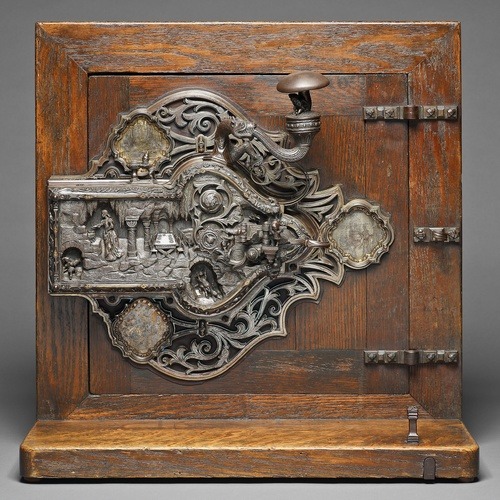
Lock, Frank L. Koralewsky, 1911, Art Institute of Chicago: American Art
Frank L. Koralewsky served as a traditional ironworker’s apprentice in his native north-German town of Stralsund. After obtaining journeyman status, he worked in various German shops before immigrating to Boston in the mid- 1890s. By 1906 he was a member of the Boston Society of Arts and Crafts, specializing in locksmithing and hardware. This extremely intricate lock, which took seven years to complete, exemplifies the early-20th-century taste for sentimental medievalism and represents the pinnacle of the metalworking tradition at the turn of the 20th century. Exhibited at the 1915 Panama-Pacific International Exposition, where it won a gold medal, the lock illustrates Jacob and Wilhelm Grimm’s fairy tale “Snow White and the Seven Dwarfs.” Gift of Mr. Richard T. Crane
Size: 50.8 × 50.8 × 20.3 cm (20 × 20 × 8 in.)
Medium: Iron with inlays of gold, silver, bronze, and copper on wood base
https://www.artic.edu/artworks/28869/
2 notes
·
View notes
Photo
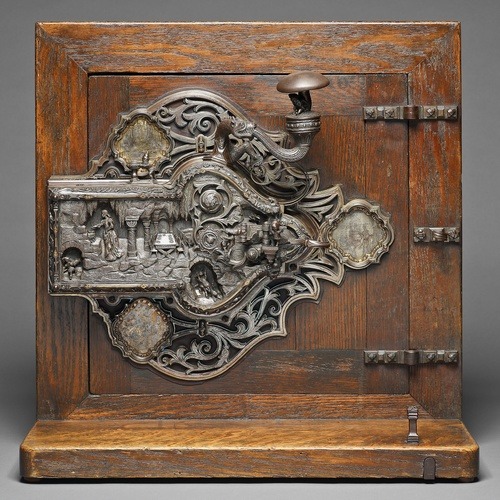
Lock, Frank L. Koralewsky, 1911, Art Institute of Chicago: American Art
Frank L. Koralewsky served as a traditional ironworker’s apprentice in his native north-German town of Stralsund. After obtaining journeyman status, he worked in various German shops before immigrating to Boston in the mid- 1890s. By 1906 he was a member of the Boston Society of Arts and Crafts, specializing in locksmithing and hardware. This extremely intricate lock, which took seven years to complete, exemplifies the early-20th-century taste for sentimental medievalism and represents the pinnacle of the metalworking tradition at the turn of the 20th century. Exhibited at the 1915 Panama-Pacific International Exposition, where it won a gold medal, the lock illustrates Jacob and Wilhelm Grimm’s fairy tale “Snow White and the Seven Dwarfs.” Gift of Mr. Richard T. Crane
Size: 50.8 × 50.8 × 20.3 cm (20 × 20 × 8 in.)
Medium: Iron with inlays of gold, silver, bronze, and copper on wood base
https://www.artic.edu/artworks/28869/
0 notes
